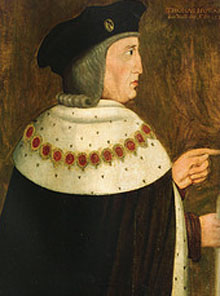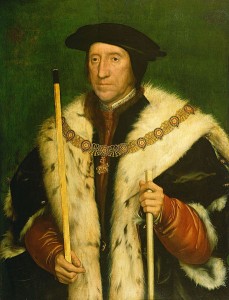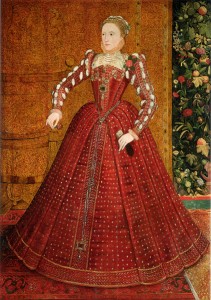Background – the Boleyns
Today the Boleyns are usually associated with Hever Castle in Kent but they were in fact a Norfolk family firmly established at Blickling. They traced their origins to Geoffrey Boleyn of Salle and Alice, daughter of Sir John Bracton (Griffiths, pg. 454).
The couple had several children, including Geoffrey Boleyn who was born c. 1405 in Blickling. According to David Loades, he was ‘the founder of the family fortune’ (pg. 9).
Geoffrey married as his second wife Anne, daughter and co-heir of Lord Hoo and Hastings. This was a beneficial match, as now the Boleyns were mixing with local gentry and the lesser nobility. Geoffrey became an alderman of the City of London in 1452, Lord Mayor in 1457-8 and was knighted by Henry VI (Weir, pg. 145).
In 1452, Geoffrey Boleyn purchased Sir John Fastolf’s Manor of Blickling and in 1462 he purchased Hever Castle in Kent.
Sir Geoffrey and Anne’s son, William, continued the trend of advantageous marriages by taking as his wife Margaret Butler, daughter of Thomas Butler, Earl of Ormond (Loades, pg. 7).
Lady Margaret and Sir Geoffrey had four sons that survived infancy and four daughters (Griffiths, pg. 454). Of their sons – Thomas, James, William and Edward – Thomas Boleyn is the most famous and earned his place in history as the father of Anne Boleyn who in 1533 married King Henry VIII.
Thomas continued the tradition of impressive unions by marrying Elizabeth Howard, daughter of Thomas Howard, Earl of Surrey and his first wife, Elizabeth Tilney. She was the eldest of two daughters and was descended from King Edward I (Fraser, pg. 116).
Weir writes of how the Howard fortunes had suffered after the Battle of Bosworth where Surrey’s father had fought on the losing side. This was fortunate for Thomas who otherwise might have found Elizabeth ‘too grand for him’ (Weir, pg. 146).
Elizabeth’s brother, Lord Thomas, was at the time married to Queen Elizabeth’s sister, Anne, who was the daughter of Edward IV and Elizabeth Woodville.
It was Thomas’ marriage to Elizabeth that brought the Boleyns ‘into the ranks of the higher Tudor nobility’ (Loades, pg 7).
Sir James Boleyn
William Boleyn owned property in Kent and Norfolk, dividing much of his time between Hever Castle and Blickling. According to Loades, it is at the latter that James Boleyn was born in 1480 (pg. 12).
For most of his life, Sir James lived in the shadow of his older brother but perhaps he deserves more of our attention. He outlived Thomas by 22 years and it was because of James that the Boleyns survived as a gentry family at Blickling until the 1560s and, ‘through the female line, survived into the seventeenth century’ (Griffiths, pg. 453).
Had he produced a male heir before his death in 1561, the Boleyns might still be at Blickling today.
What do we know about him?
– May have received legal training in his youth
– Served on the commission of the peace for Norfolk from 1511 until 1561
– He was knighted in 1520 for reasons unknown
– At some time before 1520, James married Elizabeth, the daughter of John Wood of East Barsham in Norfolk
– In 1529 he sat for Norfolk in the Reformation parliament
– He was a Knight of the Body by 1533. This position did not involve regular attendance at court and was ‘largely honorific’.
– From 1533-36 he served as chancellor in the household of his niece, Queen Anne Boleyn and his wife, Elizabeth Wood, Lady Boleyn, ‘served’ Anne during her imprisonment in the Tower and was one of the ladies that accompanied her to her trial and death in May 1536 (According to Ives, Lady Boleyn was not one of Anne’s favourite attendants)
– James survived the destruction of his niece and nephew (Anne and George Boleyn) in 1536
– In 1539 his brother, Thomas Boleyn, died
– In January 1540 he attended the third Duke of Norfolk (his kinsman by marriage) at the reception of Anne of Cleves
– In February 1540 he was granted livery of Thomas Boleyn’s lands although he was not permitted to claim the earldom of Wiltshire
– In March 1540 he exchanged newly acquired lands in Kent with the Crown for six manors and other land in Norfolk
– In 1542 he received a grant of all of Jane Rochford’s moveable property that had been left at Blickling
– In 1546 James served on the jury which indicted his kinsman Henry Howard, Earl of Surrey for high treason
– James served as custos rotulorum (“keeper of the rolls”) for Norfolk from 1558-60
– In November 1558 he saw his great-niece ascend the throne
– In 1561 he made his will, requesting to be buried at Blickling
Sir James Boleyn died in 1561 and was buried with ‘great Pomp at Blickling’ (Blomefield, pg. 627) on September 6. He left various things to Queen Elizabeth in his will, including ‘a basin and gilt ewer’ and small bequests to various nieces and nephews.
He also left Elizabeth ‘my written book of the revelations of Saint Bridget’, and Roger Virgoe, author of James’ biography published in The History of Parliament: the House of Commons 1509-1558, concludes that there is no evidence to suggest that Sir James Boleyn shared the reformist beliefs of other members of his family. Although, Eric Ives states that
‘Her chancellor was her uncle, James Boleyn, with whom, as with Cromwell, she shared some sympathies’ (pg. 211).
Since he and his wife, Elizabeth, had no surviving children ‘with him the direct male line of the Boleyns became extinct’ (Loades, pg. 18).
Read part 1 of this series of posts here.
References
Blomefield, F. and Parking, C. An essay towards a topographical history of the county of Norfolk, 2nd edn. (1805-10), volume 3.Fraser, A. The Six Wives of Henry VIII, 1999.
Griffiths, E. The Boleyns at Blickling, 1450-1560 (Norfok Archaeology, 40, 2009).
Ives, E. The Life and Death of Anne Boleyn, 2004.
Loades, D. The Boleyns: The Rise and Fall of a Tudor Family, 2011.
Weir, A. The Six Wives of Henry VIII, 2007.
The History of Parliament: The House of Commons – James Boleyn






















Thanks Natalie, this is another great article, but there is an error where it states:
“Sir Geoffrey and Anne’s son, William, continued the trend of advantageous marriages by taking as his wife Margaret Butler, daughter of Thomas Butler, Earl of Ormond (Loades, pg. 7).
Lady Margaret and Sir Geoffrey had four sons that survived infancy and four daughters…”
…whereas it should read,”Lady Margaret and William had four sons…”
Thank you Jeff! I will check this and amend. Natalie
Jeff, I see your posts on several Boleyn sites and am very interested in your research about possible descendants of George Boleyn. My grandmother was a Rochford and our family lore has always contained the story/belief of our direct lineage from Lord Rochford and ancestors’ move to Canada when the aristocracy fled France. Would love more information.
Your family lore is intriguing, because George Boleyn was also known by his title ‘Rochford’, as in ‘George Rochford’. Jane Boleyn nee Parker, George’s wife, continued to use it as her title after her husband’s execution. Queen Anne Boleyn herself is known to have signed her name as ‘Anne Rochford’, because her father Sir Thomas held the title. Later the title passed down through their sister Mary Boleyn nee Carew’s descendants.
Just as Boleyn surname variances were used to obscure association with the attainted branch, so it is quite possible that the use of Rochford as a surname, could have served the same purpose. It would conveniently be confused with a long established English Rochford family surname and/or geographically based surname variances derived from Rochford in Essex or Rochforte in France. However, because of these potentially deliberate confusions, it would require some considerable set of evidences to work back from relatively recent Rochfords back to the Boleyns in question. Do you have more info’ on your grandmother’s Rochford line? Even her full maiden name, birth and marriage details may be a starting point.
Some resources for researching Rochfords may be found here:
http://surnames.meaning-of-names.com/genealogy/rochford/
Having said that, as an example of what can be found using internet resources alone (I’m in New Zealand, so have no physical access to primary sources), I have made some more progress on the Irish Boleyn connection. I have turned up yet another Boleyn, one Mrs Mary Bullen in Ireland, who was said to have been descended (or more likely her husband) from King Henry VIII’s Queen. She worked for Jane Molyneux nee Usher, in what seems to have been role as governess, and later became (I assume after her Bullen husband died), Lady Paisley, as is explained here:
https://books.google.co.nz/books?id=9qJVAAAAcAAJ&pg=PA21
This Mrs Mary Bullen, would be of a suitable generation (although not sure of age) to be mother or aunt to the Clonony Castle Bullyn girls or that of Anna Newcomen nee Bullein. Certainly she could well have known the Newcomens, because Jane Usher’s husband Daniel had a sister Catherine Molyneux, who married the father of Sir Robert Newcomen, 4th Baronet, that in turn married Anna Bullein (said to be great grand-niece to Queen Anne Boleyn).
I have not yet been able to identify which generation of Lord Paisley (the Paisley title passing through a line surnamed Hamilton) that Mrs Mary Bullen married. There is also a possibility that she married an ennobled man surnamed Peisley; that spelling confused with Paisley.
To bring this discussion back on topic, Mrs Mary Bullen’s first husband may well have been among the last male of Queen Anne’s father’s Boleyn line, unless the ‘Rochford’ connection proves valid.
Thank you! I responded to this in a separate thread below. Wanted to add here: Very interesting indeed, especially since my Rochfords fled France via Ireland before coming to Canada.
Best, Andrea
An errata to my reply is that the last sentence of the first paragraph should read:
“… sister Mary Boleyn’s Carew descendants.
Actually it should say “… sister Mary Boleyn’s Cary descendants.”
Thank you, Jeff! Sorry it’s taken awhile to see/respond to this. I just now posted a query with more family details on another of your comments on another website (https://www.blogger.com/comment.g?blogID=16981893&postID=326876868165626911&page=1&token=1478808007965&bpli=1) and then found your response to my earlier note here.
Thank you so much! Here’s a bit more info.
A hand-written entry in our Rochford Family Recipe Book reads in full:
From the Osborne, Kansas, newspaper during World War I:
“The mother’s* ancestors were among the refugees in the flight of the aristocracy from France during the Wars and were shipwrecked off Ireland and settled there, founding the Rochford family of Meath County, Ireland. She, with her parents, came to Quebec, Canada, after the War of 1812. The family came to Minnesota during the Civil War and changed the spelling of their name in getting citizen papers.”
*Mother refers to Jessie Vague’s mother who is a sister of Grandfather (John Henry) Rochford’s father.”
Best to you, Jeff,
Andrea Thorsen Turman
I have read the posts with much interest. My maternal ancestry has the surname of Gay and from documented evidence they farmed in the area of Ingworth and Blickling in Norfolk moving on to Oulton and Wood Dalling and lastly in Mattishall Borough and Mattishall. I have also found the surname of Gray popping up in my research!! One of my ancestors was a William Ireland Gay who lived at Stinton Hall in Salle. Any comments appreciated.